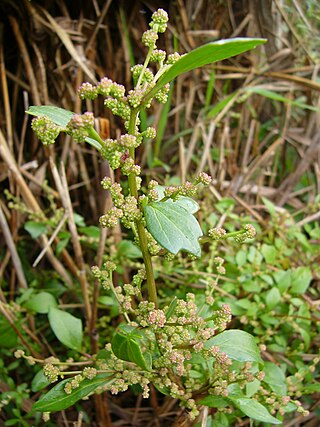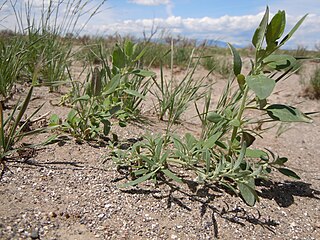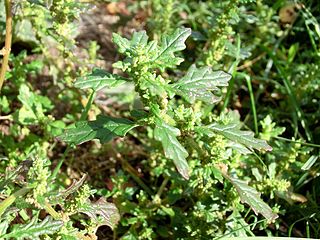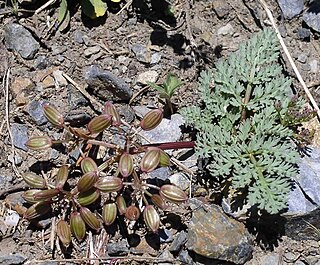
Chenopodium is a genus of numerous species of perennial or annual herbaceous flowering plants known as the goosefoot, which occur almost anywhere in the world. It is placed in the family Amaranthaceae in the APG II system; older classification systems, notably the widely used Cronquist system, separate it and its relatives as Chenopodiaceae, but this leaves the rest of the Amaranthaceae polyphyletic. However, among the Amaranthaceae, the genus Chenopodium is the namesake member of the subfamily Chenopodioideae.

Chenopodiastrum murale, is a species of plant in the family Amaranthaceae known by the common names nettle-leaved goosefoot, Australian-spinach, salt-green, and sowbane. This plant is native to Europe and parts of Asia and northern Africa, but it is widespread worldwide, particularly in tropical and subtropical areas due to the ease of it being introduced. It is a common weed of fields and roadsides.

Blitum californicum is a species of flowering plant in the amaranth family known by the common names California goosefoot and (ambiguously) "Indian lettuce".

Oxybasis chenopodioides, is a species of flowering plant in the family Amaranthaceae known by the common name low goosefoot.
Chenopodium desiccatum is a species of flowering plant in the family Amaranthaceae known by the common names aridland goosefoot and slimleaf goosefoot.

Chenopodium fremontii is a species of flowering plant in the family Amaranthaceae known by the common name Frémont's goosefoot. Both the species' specific epithet, and the common name derive from the 19th century western pioneer John C. Frémont.
Chenopodium hians is a species of flowering plant in the family Amaranthaceae known by the common names hians goosefoot and gaping goosefoot. The Latin species name hians means "gaping".

Chenopodium leptophyllum is a species of flowering plant in the family Amaranthaceae known by the common name narrowleaf goosefoot.

Dysphania multifida is a species of flowering plant in the family Amaranthaceae known by the common names cutleaf goosefoot and scented gooosefoot.

Chenopodium pratericola is a species of flowering plant in the goosefoot family known by the common name desert goosefoot. It is native to much of western and central North America, where it grows in many types of open habitat, such as sagebrush, often on alkaline soils.

Dysphania pumilio is a species of flowering plant in the family Chenopodioideae known by the common name clammy goosefoot.

Mentzelia albicaulis is a species of flowering plants in the family Loasaceae known by the common names whitestem blazingstar, white-stemmed stickleaf, and small flowered blazing star. It is native to much of western North America, where it grows in mountain, desert, and plateau habitat.
Nemacladus interior is a species of flowering plant in the bellflower family known by the common name Sierra threadplant. It is native to the Sierra Nevada of California, and it is known from Oregon as well. It grows in mountain forest habitat. It is an annual herb producing a stiff upright purple-brown stem up to about 25 centimeters tall. Small toothed oval leaves 1 to 2 centimeters long occur at the base of the plant. The inflorescence is a zigzagging series of branches bearing occasional flowers on thin pedicels. There is a single tiny bract at the base of each pedicel. The flower is a few millimeters long. It has five triangular sepals and five corolla lobes, three lobes on the upper lip and two on the lower. The corolla is white to pale purple or pink with a thin red band and yellow spot at the base of each lobe.

Porterella is a monotypic genus of flowering plants in the bellflower family containing the single species Porterella carnosula, which is known by the common name fleshy porterella, or simply porterella.

Scutellaria antirrhinoides is a species of flowering plant in the mint family known by the common names nose skullcap and snapdragon skullcap. It is native to the western United States, where it grows in forests, woodlands, and open, rocky habitat types. It is a perennial herb producing an erect stem or cluster of stems up to 35 centimeters tall from a system of thin rhizomes. The stems are coated in short hairs which are curled or angled upward and sometimes have resin glands. The oval leaves are coated in tiny hairs and are oppositely arranged. The lowest leaves are borne on short petioles. Flowers emerge from the leaf axils. Each flower is held in a calyx of sepals with a large ridge or appendage on the upper part. The corolla measures up to 2 cm long, tubular in shape with a large upper and lower lip. The upper lip is folded into a beaklike protrusion and the lower has three flat lobes. The corolla is purple to blue with an area of white mottling on the lower lip.
Stellaria irrigua is a species of flowering plant in the family Caryophyllaceae known by the common names umbrella starwort and umbellate starwort. It is native to western North America from Alaska and north-western Canada to the south-western United States, as well as parts of Asia, including Siberia. It grows in subalpine and alpine climates in mountain forests and riverbanks. It is a rhizomatous perennial herb producing a slender prostrate stem up to about 20 centimeters long, sometimes forming clumps or mats. The stem is lined with pairs of oval leaves each up to about 2 centimeters long. The inflorescence is an umbel-shaped array of several flowers each on an arching or erect pedicels. The flower has five pointed green sepals each no more than 3 millimeters long. There are occasionally tiny white petals within the calyx of sepals, but these are generally absent.

Symphoricarpos longiflorus is a species of flowering plant in the honeysuckle family known by the common names desert snowberry and fragrant snowberry. It is native to the western United States from the Great Basin to western Texas, as well as northwestern Mexico.
Chenopodium incognitum is a species of annual flowering plant in the family Amaranthaceae. It is difficult to tell apart from Chenopodium hians and Chenopodium atrovirens is often synonymized with one of those species by botanical authorities.

Lomatium erythrocarpum, known by the common name redfruit desertparsley, is a rare species of flowering plant in the carrot family. It is endemic to Oregon in the United States, where it is limited to a section of the Blue Mountains within Baker County.
Chenopodium cycloides is a species of flowering plant in the family Amaranthaceae known by the common name sandhill goosefoot. It is native to the south-central United States.















